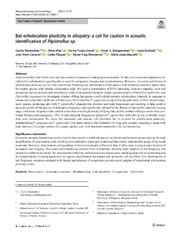Приказ основних података о документу
Bat echolocation plasticity in allopatry: a call for caution in acoustic identification of Pipistrellus sp.
| dc.creator | Montauban, Cecilia | |
| dc.creator | Mas, Maria | |
| dc.creator | Tuneu-Corral, Carme | |
| dc.creator | Wangensteen, Owen S. | |
| dc.creator | Budinski, Ivana | |
| dc.creator | Martí-Carreras, Joan | |
| dc.creator | Flaquer, Carles | |
| dc.creator | Puig-Montserrat, Xavier | |
| dc.creator | López-Baucells, Adrià | |
| dc.date.accessioned | 2021-03-29T09:31:16Z | |
| dc.date.available | 2021-03-29T09:31:16Z | |
| dc.date.issued | 2021 | |
| dc.identifier.issn | 0340-5443 | |
| dc.identifier.uri | https://radar.ibiss.bg.ac.rs/handle/123456789/4169 | |
| dc.description.abstract | Animals modify their behaviours and interactions in response to changing environments. In bats, environmental adaptations are reflected in echolocation signalling that is used for navigation, foraging and communication. However, the extent and drivers of echolocation plasticity are not fully understood, hindering our identification of bat species with ultrasonic detectors, particularly for cryptic species with similar echolocation calls. We used a combination of DNA barcoding, intensive trapping, roost and emergence surveys and acoustic recording to study a widespread European cryptic species complex (Pipistrellus pipistrellus and Pipistrellus pygmaeus) to investigate whether sibling bat species could exhibit extreme echolocation plasticity in response to certain environmental conditions or behaviours. We found that P. pygmaeus occupied the acoustic niche of their absent congeneric species, producing calls with P. pipistrellus’ characteristic structure and peak frequencies and resulting in false positive acoustic records of that species. Echolocation frequency was significantly affected by the density of bats and by maternity rearing stage, with lower frequency calls emitted when there was a high density of flying bats, and by mothers while juveniles were non-volant. During roost emergence, 29% of calls had peak frequencies typical of P. pipistrellus, with calls as low as 44 kHz, lower than ever documented. We show that automatic and manual call classifiers fail to account for echolocation plasticity, misidentifying P. pygmaeus as P. pipistrellus. Our study raises a vital limitation of using only acoustic sampling in areas with high densities of a single species of a cryptic species pair, with important implications for bat monitoring. | sr |
| dc.language.iso | en | sr |
| dc.publisher | Springer Nature | sr |
| dc.relation | Catalan government and theGranollers Natural Sciences Museum (convention reference DB201804) | sr |
| dc.rights | openAccess | sr |
| dc.rights.uri | https://creativecommons.org/licenses/by/4.0/ | |
| dc.source | Behavioral Ecology and Sociobiology | sr |
| dc.subject | Bioacoustics | sr |
| dc.subject | Automatic classifiers | sr |
| dc.subject | Metabarcoding | sr |
| dc.subject | Call variability | sr |
| dc.subject | Conspecifics | sr |
| dc.subject | Pipistrellus | sr |
| dc.title | Bat echolocation plasticity in allopatry: a call for caution in acoustic identification of Pipistrellus sp. | sr |
| dc.type | article | sr |
| dc.rights.license | BY | sr |
| dcterms.abstract | Wангенстеен, Оwен С.; Мартí-Царрерас, Јоан; Флаqуер, Царлес; Пуиг-Монтсеррат, Xавиер; Лóпез-Бауцеллс, Aдриà; Монтаубан, Цецилиа; Мас, Мариа; Тунеу-Цоррал, Царме; Будински, Ивана; | |
| dc.rights.holder | © 2021 by the authors | sr |
| dc.citation.volume | 75 | |
| dc.identifier.doi | 10.1007/s00265-021-03002-7 | |
| dc.identifier.wos | 000632768000002 | |
| dc.citation.apa | Montauban, C., Mas, M., Tuneu-Corral, C., Wangensteen, O. S., Budinski, I., Martí-Carreras, J., et al. (2021). Bat echolocation plasticity in allopatry: a call for caution in acoustic identification of Pipistrellus sp. Behavioral Ecology and Sociobiology, 75(4), 70. | |
| dc.citation.vancouver | Montauban C, Mas M, Tuneu-Corral C, Wangensteen OS, Budinski I, Martí-Carreras J, Flaquer C, Puig-Montserrat X, López-Baucells A. Bat echolocation plasticity in allopatry: a call for caution in acoustic identification of Pipistrellus sp. Behav Ecol Sociobiol. 2021;75(4):70. | |
| dc.citation.spage | 70 | |
| dc.type.version | publishedVersion | sr |
| dc.identifier.fulltext | https://radar.ibiss.bg.ac.rs/bitstream/id/8292/bitstream_8292.pdf | |
| dc.citation.rank | aM21 |

